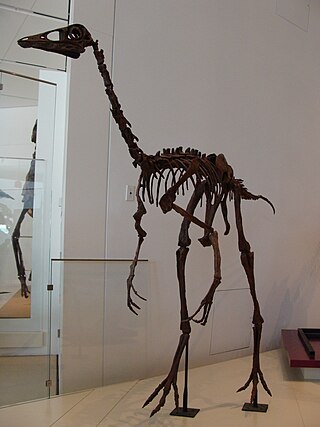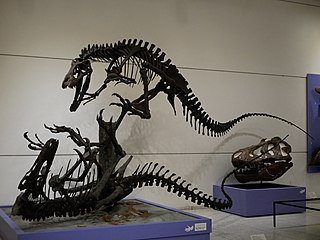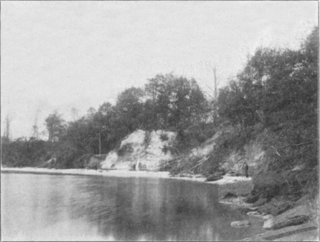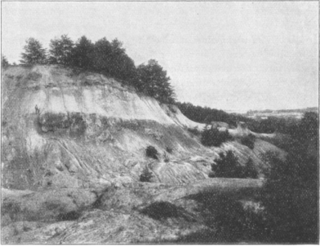
Ornithomimus is a genus of ornithomimid theropod dinosaurs from the Campanian and Maastrichtian ages of Late Cretaceous Western North America. Ornithomimus was a swift, bipedal dinosaur which fossil evidence indicates was covered in feathers and equipped with a small toothless beak that may indicate an omnivorous diet. It is usually classified into two species: the type species, Ornithomimus velox, and a referred species, Ornithomimus edmontonicus. O. velox was named in 1890 by Othniel Charles Marsh on the basis of a foot and partial hand from the Denver Formation of Colorado. Another seventeen species have been named since then, though almost all of them have been subsequently assigned to new genera or shown to be not directly related to Ornithomimus velox. The best material of species still considered part of the genus has been found in Alberta, representing the species O. edmontonicus, known from several skeletons from the Horseshoe Canyon Formation. Additional species and specimens from other formations are sometimes classified as Ornithomimus, such as Ornithomimus samueli from the earlier Dinosaur Park Formation.

Appalachiosaurus is a genus of basal eutyrannosaurian theropod dinosaur from the middle Campanian age of the Late Cretaceous period of what is now eastern North America. Like most theropods, it was a bipedal predator. Only a juvenile skeleton has been found, representing an animal approximately 6.5 metres (21 ft) long and weighing 623 kilograms (1,373 lb), which indicates an adult would have been significantly larger. It is the most completely known theropod from eastern North America.

Tyrannosauroidea is a superfamily of coelurosaurian theropod dinosaurs that includes the family Tyrannosauridae as well as more basal relatives. Tyrannosauroids lived on the Laurasian supercontinent beginning in the Jurassic Period. By the end of the Cretaceous Period, tyrannosauroids were the dominant large predators in the Northern Hemisphere, culminating in the gigantic Tyrannosaurus. Fossils of tyrannosauroids have been recovered on what are now the continents of North America, Europe and Asia, with fragmentary remains possibly attributable to tyrannosaurs also known from South America and Australia.

Dryptosaurus is a genus of basal eotyrannosaurian theropod dinosaur that lived on the island continent of Appalachia approximately 67 million years ago during the end of the Maastrichtian age of the Late Cretaceous period. Dryptosaurus was a large, bipedal, ground-dwelling carnivore that could grow up to 7.5 metres (25 ft) long and weigh up to 756–1,500 kilograms (1,667–3,307 lb). Although it is now largely unknown outside of academic circles, the famous 1897 painting of the genus by Charles R. Knight made Dryptosaurus one of the more widely known dinosaurs of its time, in spite of its poor fossil record. First described by Edward Drinker Cope in 1866 and later renamed by Othniel Charles Marsh in 1877, Dryptosaurus is among the first theropod dinosaurs ever known to science.
"Coelosaurus" antiquus is a dubious species of theropod dinosaurs. It was named by Joseph Leidy in 1865 for two tibiae found in the Navesink Formation of New Jersey.

Hypsibema is an extinct genus of hadrosaurid dinosaurs from the Late Cretaceous (Campanian-aged) Black Creek Group of North Carolina. The type species is H. crassicauda, with a potential second species in H. missouriensis.

Santanaraptor is a genus of tyrannosauroid theropod dinosaur that lived in South America during the Early Cretaceous, about 112 million years ago.
The Cedar Mountain Formation is the name given to a distinctive sedimentary geologic formation in eastern Utah, spanning most of the early and mid-Cretaceous. The formation was named for Cedar Mountain in northern Emery County, Utah, where William Lee Stokes first studied the exposures in 1944.

The Arundel Formation, also known as the Arundel Clay, is a clay-rich sedimentary rock formation, within the Potomac Group, found in Maryland of the United States of America. It is of Aptian age. This rock unit had been economically important as a source of iron ore, but is now more notable for its dinosaur fossils. It consists of clay lenses within depressions in the upper part of the Patuxent Formation that may represent oxbow swamp facies. It is named for Anne Arundel County, Maryland.
The Kanguk Formation is a geological formation in the Northwest Territories and Nunavut, Canada whose strata date back to the Late Cretaceous. Dinosaur remains are among the fossils that have been recovered from the formation.
The Moreno Hill Formation is a geological formation in western New Mexico whose strata were deposited in the Late Cretaceous. Dinosaur remains are among the fossils that have been recovered from the formation. The age of the formation is dated between approximately 90.9 to 88.6 million years ago based on detrital zircons.
The Merchantville Formation is a geological formation in the northeastern United States whose strata date back to the Late Cretaceous, around the time of the Santonian and Campanian age. Dinosaur remains are among the fossils that have been recovered from the formation.
The Mooreville Chalk is a geological formation in North America, within the U.S. states of Alabama and Mississippi, which were part of the subcontinent of Appalachia. The strata date back to the early Santonian to the early Campanian stage of the Late Cretaceous. The chalk was formed by pelagic sediments deposited along the eastern edge of the Mississippi embayment. It is a unit of the Selma Group and consists of the upper Arcola Limestone Member and an unnamed lower member. Dinosaur, mosasaur, and primitive bird remains are among the fossils that have been recovered from the Mooreville Chalk Formation.
The Donoho Creek Formation is a Mesozoic geologic formation in South Carolina. Dinosaur remains are among the fossils that have been recovered from the formation.

The Raritan Formation is a Cretaceous (Turonian) sedimentary geologic formation of the Atlantic Coastal Plain.
The Marshalltown Formation is a Mesozoic geologic formation. Dinosaur remains diagnostic to the genus level are among the fossils that have been recovered from the formation.
The Mount Laurel Formation is a Mesozoic geologic formation located in New Jersey and Delaware. Dinosaur remains diagnostic to the genus level are among the fossils that have been recovered from the formation. Dinosaur teeth recovered from this formation include tyrannosauroid teeth similar to those of Dryptosaurus, as well as teeth from a ~3-4m saurornitholestine dromaeosaurid. Other fossils include: Belemnites in the genus Belemnitella, Oysters such as Exogyra and Pycnodonte, and rare mosasaur, turtle, and plesiosaur remains.

During most of the Late Cretaceous the eastern half of North America formed Appalachia, an island land mass separated from Laramidia to the west by the Western Interior Seaway. This seaway had split North America into two massive landmasses due to a multitude of factors such as tectonism and sea-level fluctuations for nearly 40 million years. The seaway eventually expanded, divided across the Dakotas, and by the end of the Cretaceous, it retreated towards the Gulf of Mexico and the Hudson Bay. This left the island masses joined in the continent of North America as the Rocky Mountains rose. From the Cenomanian to the end of the Campanian ages of the Late Cretaceous, Appalachia was separated from the rest of North America. As the Western Interior Seaway retreated in the Maastrichtian, Laramidia and Appalachia eventually connected. Because of this, its fauna was isolated, and developed very differently from the tyrannosaur, ceratopsian, hadrosaurid, pachycephalosaur and ankylosaurid dominated fauna of the western part of North America, known as "Laramidia".
The Tar Heel Formation is a geologic formation in North Carolina. It preserves fossils, including amber dating back to the Cretaceous period. A locality known as Phoebus Landing, has been dated to 78.5-77.1 Ma.

The Potomac Group is a geologic group in Delaware, Maryland, New Jersey, and Virginia. It preserves fossils dating back to the Cretaceous period. An indeterminate tyrannosauroid and Priconodon crassus, a nodosaurid, are known from indeterminate sediments belonging to the Potomac Group. The Potomac Group was initially believed to have been Late Jurassic in age by Othniel Charles Marsh but later studies, such as Clark (1897), have found that the Potomac Group is in fact Early-Late Cretaceous (Aptian-Turonian) in age.









